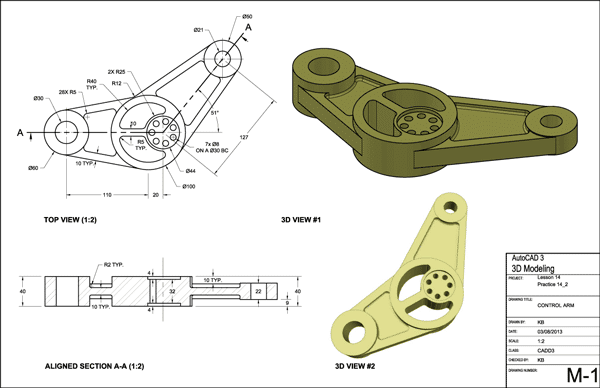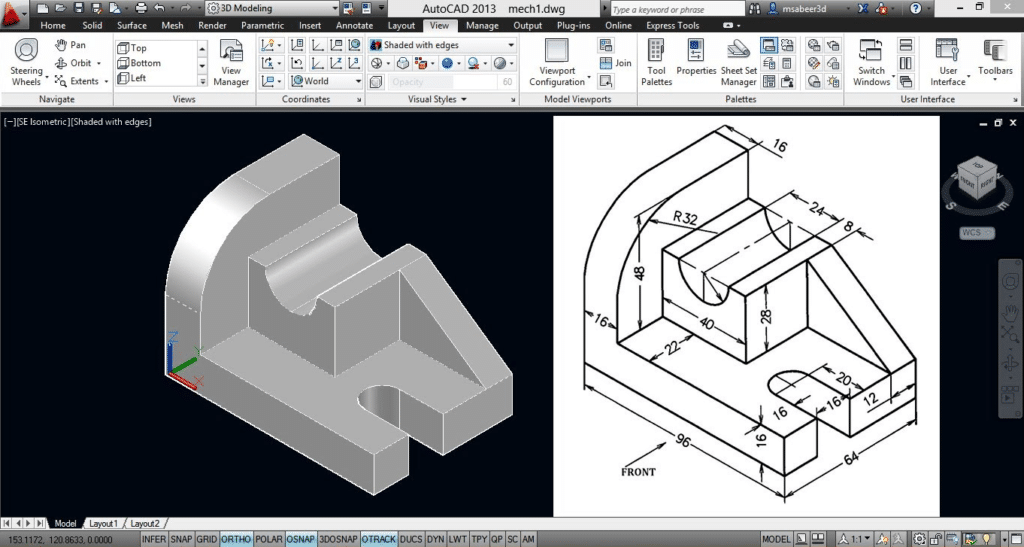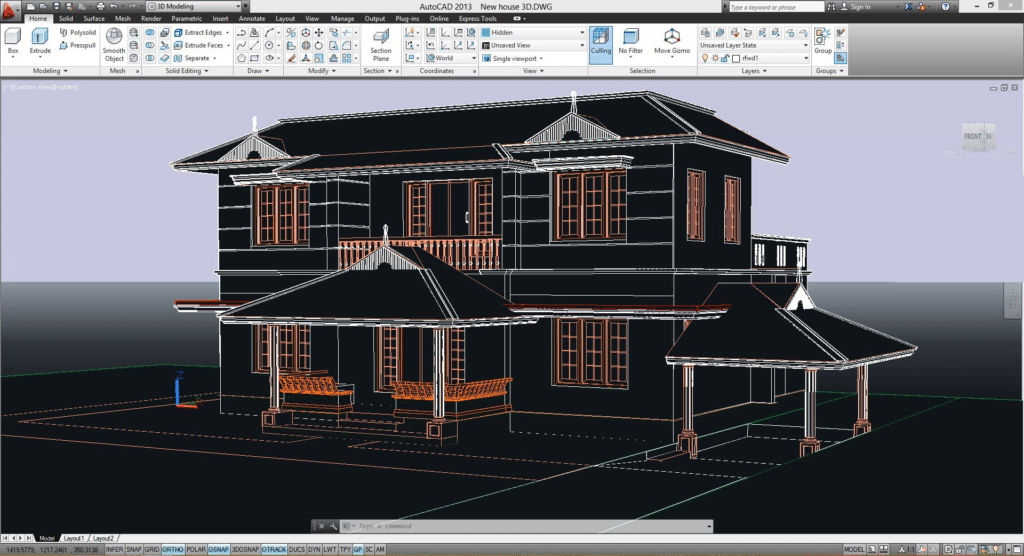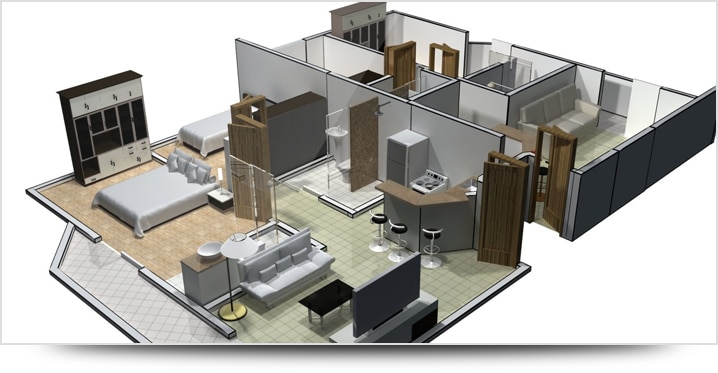AutoCAD is an integral part of the CAD industry—not just as a piece of software, but also as a necessary skill across many industries. Whether it’s drafting or engineering, you won’t be able to go very far without having the necessary AutoCAD skills. So what type of AutoCAD careers are out there? And what qualifications are needed? Scan2CAD has all of the answers for you!
Check out our handy guide for an overview of AutoCAD careers and all the statistics you need to know—salaries, certifications, responsibilities, and even pros and cons. Scan2CAD has it all!
Table of Contents
AutoCAD Jobs

As we’ve already mentioned, AutoCAD is used across various industries, which is why it’s a prerequisite skill for many potential jobs. In fact, some sectors will have it as part of the potential job title, e.g. ‘AutoCAD Electrical Drafter’. But regardless, possessing this skill actually opens your world up to the possibility of landing lucrative career, as the CAD jobs are well-paying with high salaries. For more on this, check out our analysis on the highest paying jobs in the CAD industry.
Although there are many AutoCAD career options out there, we’re going to concentrate on four main groups:
Drafting Jobs in CAD Industry
 Drafters use software like AutoCAD to convert the designs of engineers or architects into technical drawings and blueprints. These drawings will be used to create structures, tools or machines. The designs also include specifications like dimensions, materials and procedures.
Drafters use software like AutoCAD to convert the designs of engineers or architects into technical drawings and blueprints. These drawings will be used to create structures, tools or machines. The designs also include specifications like dimensions, materials and procedures.
Software like AutoCAD has become a necessity in this career sector, as it enables people to create designs that can be reworked and modified. Unlike a real-world prototype, an AutoCAD prototype can be improved until it functions perfectly. This same software can also be used to simulate how well a prototype will function under stress or high-pressure. And with AutoCAD’s extensive libraries and templates, the possibilities have, consequently, become endless.
Here are the most common drafting jobs in the CAD industry (CAD drafter jobs):
- Mechanical drafter
- Electrical drafter
- Electronics drafter
- Civil drafter
- Architectural drafter
1. Mechanical Drafter
Average Salary: $62,650 (Data released March 2022)
Mechanical Drafter Responsibilities
- Draft layouts and sketches
- Create 2D drawings of 3D models
- Update and revise 2D drawings based on engineer’s recommendations
- Produce estimates and specifications
- Determine equipment and material to be used
- Generate reports
- Ensure accuracy and completeness of drafts
- Calculate engineering properties such as stress, strain, etc. as well as resolve design problems
- Specify dimensions of parts
- Test and document component testing
- Manage and store drawings and drawing files electronically and safeguard their quality
Mechanical Drafter Certifications
- Mechanical Certified Drafter (CD): Certified by American Design Drafting Association (ADDA)
- ADDA Mechanical Apprentice Drafter
- Certified Technology Specialist-Design: Certified by the Audiovisual and Integrated Experience Association (AVIXA)
- Certified Design Drafter: Certified by ADDA
- Autodesk Certified Professional in AutoCAD for Design and Drafting
- Autodesk Certified Professional in Revit for Mechanical Design
- Autodesk Certified Professional in Inventor for Mechanical Design
- Autodesk Certified Associate in CAD for Mechanical Design
About Mechanical Drafters
Mechanical drafters are responsible for creating technical drawings for machinery or mechanical devices, often including factors like dimension or fastening methods. These drawings will then be used for the assembly or construction of the machines or mechanical devices. These drafters are also responsible for analyzing factors like weight, volume and dimensions—advising engineers when any corrections need to be made.
AutoCAD is useful for running simulations of designs—allowing drafters to review them for manufacturability and functionality, and make relevant modifications.
2. Electrical and Electronics Drafter
Average Salary: $67,090
There are two categories of electrical and electronics drafters:
- Electrical drafters
- Electronics drafters
Electrical Drafter Responsibilities
- Prepare wiring diagrams for installation or repairing works in commercial buildings, power plants, or electricity distribution stations
- Create visual guidelines for construction purposes
- Outline dimensions, materials, and procedures
- Explain concepts to installation crews
- Supervising installation and repairs
- Inspecting and testing installed works
- Generate user manuals, technical documentation, and installation guides
Electronics Drafter Responsibilities
- Generate wire, schematic, block, control, and logic diagrams
- Prepare assembly diagrams for circuit boards and layout diagrams used in manufacturing, installation, or repair of electronic devices or parts
- Develop specifications by referencing and examining electronic schematics and documents
- Program drawings into automated manufacturing systems
- Draft technical details
- Plot electrical test points
- Determine and define all design elements
Electrical and Electronics Drafter Certifications
- Autodesk Certified Professional in AutoCAD for Design and Drafting
- Autodesk Certified Professional in Revit for Electrical Design
About Electrical Drafters
Electrical drafters prepare technical plans for the manufacturing, installation or repair of wiring systems. They analyze information given to them by engineers, and apply their knowledge to create specifications that include factors like dimension and installation procedures. This type of drafting can be used in a variety of locations, including homes, power plants and communication hubs.
About Electronics Drafters
Electronics drafters are generally responsible for drafting wiring diagrams, layout diagrams, schematics, and circuit board assembly diagrams used in the manufacture, installation, or repair of electronic components or equipment. Unlike electrical drafters who can work on commercial buildings or homes, electronics drafters are confined to their offices as they work for manufacturers or repair shops.
AutoCAD’s library of electrical symbols enables both electrical and electronics drafters to create detailed plans, and even estimated material costs.
3. Architectural Drafter
Average Salary: $60,620
Architectural Drafter Responsibilities
- Prepare architectural drawings – using CAD software – based on codes, specifications, and available space
- Visit and collect dimensions and measurements on-site
- Organize electrical and structural drawings in order to incorporate them into architectural drawings
- Work with the architect to ensure the project meets the design specifications
- Determine and specify the type of material needed and their quantity
- Generate cost estimates and prepare contracts in collaboration with the architect
Architectural Drafter Certifications
- Autodesk Certified Professional in AutoCAD for Design and Drafting
- Autodesk Certified Professional in Revit for Architectural Design
- ADDA Architectural Certified Drafter
- ADDA Architectural Apprentice Drafter
- Graphisoft Certified ArchiCAD Professional
About Architectural Drafters
Architectural drafters produce blueprints and drawings for foundations, buildings and structures. These designs are used in the construction or remodeling of homes, commercial buildings and power stations, for example. These drafters will work with both exterior and interior structures—taking into consideration factors like weight, volume and stress when creating their designs.
AutoCAD enables architectural drafters to draw elements with real-world behavior—with an extensive library of components to create floor plans and 3D renderings.
4. Civil Drafter
Average Salary: $60,620
Civil Drafter Responsibilities
- Produce drawings using CAD software
- Draft 2D plans and detailed drawings of different structural components for construction projects
- Transform rough sketches and drawings from civil engineers into designs that conform to civil engineering codes and specifications
- Use surveys and cross sections to draw maps, contour diagrams, and profiles that represent elevations, topography, and subsurface structures and formations
- Interpret, modify, and correlate data from geophysical prospecting reports, logs, and topographical surveys
- Conduct or oversee field surveys, technical investigations, and inspections to acquire data to use in the drafting process
- Explain drawings to construction teams
- Calculate engineering parameters such as load, stress, strain as well as their impact on the design
- Determine and specify the quantity, quality, cost, and strength of materials
- Calculate cut and fill tonnage
- Determine the method of presenting the drawings, i.e., whether isometric or orthographic
Civil Drafter Certifications
- Autodesk Certified Professional in AutoCAD for Design and Drafting
- Autodesk Certified Professional in Revit for Structural Design
- Autodesk Certified Professional in Civil 3d for Infrastructure Design
- ADDA Civil Certified Design Drafter
- ADDA Civil Certified Design Technician
- ADDA Civil Certified Senior Designer
About Civil Drafters
Civil drafters produce drawings for structures, installations and construction projects like water systems, roads, bridges and flood control projects. These drawings also include topographical maps and diagrams to represent elevation. Civil drafters are responsible for reviewing designs produced by civil engineers to ensure they conform to design concepts. They also determine the quality or cost of materials used, and calculate the weight, volume and stress of their designs.

Image source: gbccadd.com
Engineering Jobs in CAD Industry
Engineers use software like AutoCAD to produce designs and specifications for the manufacturing or modification of mechanical components or systems. AutoCAD enables them to design these parts, and run simulations—testing factors like stress endurance to see how well these designs will function in high-pressure situations. It’s also useful for running cost estimates and checking factors like dimension, volume or weight.
The most common engineering jobs in the CAD industry are:
- Mechanical engineer
- Electrical engineer
- Electronics engineer
- Civil engineer
- Industrial engineer
1. Mechanical Engineer
Average Salary: $97,000
Mechanical Engineer Responsibilities
- Conceptualize, plan, and create mechanical designs for products
- Come up with testing procedure, test, and validate the tests
- Produce working prototypes for demonstration and beta testing
- Undertake engineering calculations to be used in design work
- Collaborate with mechanical drafters and engineering teams
- Perform documentation to keep track of the product development
- Create and review technical documents and drawings using CAD software
Mechanical Engineer Certifications
- Certified Manufacturing Engineer (CMfgE) Certification: certified by SME
- Certified Quality Engineer (CQE): certified by ASQ
- Certified Systems Engineering Professional (CSEP): certified by INCOSE
- Autodesk Certified Professional in AutoCAD for Design and Drafting
- Autodesk Certified Professional in Revit for Mechanical Design
- Autodesk Certified Professional in Inventor for Mechanical Design
- Autodesk Certified Associate in CAD for Mechanical Design
- Autodesk Certified Professional in Design for Manufacturing
- Autodesk Certified Professional in Simulation for Static Stress Analysis (using Fusion 360)
- Autodesk Certified Expert in Generative Design for Manufacturing (using Fusion 360)
- Autodesk Certified Expert in CAM for Multi-Axis Milling (using Fusion 360)
About Mechanical Engineering/Engineers
Mechanical engineers design, develop and test mechanical devices such as tools, engines and machines. They design machines and processes to solve practical problems—this could range from aircraft, to hydraulic systems, to computer circuits. These engineers will develop their designs, and test the prototypes—analyzing the results and making changes where required.
2. Electrical Engineer
Average Salary: $107,890
Electrical Engineer Responsibilities
- Generate electrical systems’ designs, reports, and design narratives
- Create and maintain electrical designs
- Use advanced product design and analytical (CAD and CAE) software
- Supervise the work of technicians and electrical drafters
- Present technical briefings
- Help in the development of new products, systems, and processes
- Develop and help maintain project timelines and budgets
- Develop and oversee test programs
- Create brief technical reports for customers
- Ensure adherence to best design practices
Electrical Engineer Certification
- Associate Systems Engineering Professional (ASEP): certified by INCOSE
- Certified Systems Engineering Professional (CSEP): certified by INCOSE
- Expert Systems Engineering Professional (ESEP) certification: certified by INCOSE
- Autodesk Certified Professional in Revit for Electrical Design
About Electrical Engineers
Electrical engineers conceptualize, design, develop, supervise the manufacture of, and test electrical equipment, components, and devices. Their responsibilities involve working with power generators and motors, communication systems, navigation equipment, and electronic systems in aircraft and automobiles.
3. Electronics Engineer
Average Salary: $115,490
Electronics Engineer Responsibilities
- Design, inspect, test, and update electronic systems
- Recommend upgrades and improvements in existing procedures
- Develop and perform maintenance, operational, and testing procedures for electronic equipment
- Prepare design documentation, test reports, and other technical documents
- Write specifications and instructions
Electronics Engineer Certification
- Master Certified Electronics Technician (CETma): certified by ETAI
- Project Management Professional (PMP): certified by PMI
About Electronic Engineers
Electronics engineers conceptualize, design, develop, evaluate, and maintain electronic components and systems. While they may be employed by small and large companies that operate in commercial sectors, their day-to-day activities generally include planning, undertaking research, designing, and inspecting equipment. The equipment includes GPS devices, communication and broadcast systems, monitor displays, music players, satellites, flight systems, and more. They are also responsible for electronic devices that are central to the operation of computers, transportation vessels, and aviation (avionics).
4. Civil Engineer
Average Salary: $95,490
Civil Engineer Responsibilities
- Write/review and approve data from surveys, plans, and reports
- Analyze field data, maps, and reports in order to plan and design projects
- Prepare design reports and construction plans based on local standards and codes
- Liaise with the client to define the scope of work and deliverables
- Work with civil drafters and other members of the civil engineering team to produce design drawings using CAD software
- Assess, choose, and apply standard engineering procedures and techniques
- Coordinate and supervise field survey teams and work
- Plan, assign, and oversee the work of the members of the engineering team
- Coordinate with different teams – architects, contractors, engineers, and client – to ensure timely delivery of the project
- Ensure rules, safety standards, and codes are followed throughout the course of a project
- Make presentations
- Come up with and apply engineering solutions to complex problems
Civil Engineer Certification
- Certified Construction Manager (CCM): certified by CMAA
- Project Management Professional (PMP): certified by PMI
- Autodesk Certified Professional in AutoCAD for Design and Drafting
- Autodesk Certified Professional in Revit for Structural Design
- Autodesk Certified Professional in Civil 3D for Infrastructure Design
About Civil Engineers
Civil engineers design and plan for the construction of building structures and systems in the public and private sector. They also design or plan for infrastructure like roads, railways, airports and irrigation projects. They develop detailed plans for these projects, taking into consideration risk assessment, cost estimates and environmental hazards.
5. Industrial Engineer
Average Salary: $95,200
Industrial Engineer Responsibilities
- Design control systems
- Coordinate activities such as production planning
- Implement quality control procedure to solve quality control issues
- Determine ways to maximise efficiency of service delivery
- Undertake/lead research to determine best location to set up a manufacturing plant
- Design layouts of manufacturing facilities
- Prepare production reports and manage process documentation
- Liaise with other teams to develop design and production standards
- Develop, supervise, and implement process improvements and technological upgrades
- Generate cost analyses, material and equipment lists, and purchase order
- Calculate estimated production costs
- Review specifications, schedules, and procedures
About Industrial Engineers
Industrial engineers focus primarily on efficiency—looking at the ways they can eliminate wastefulness in production processes. They review the basic factors of production like people and machines, to make a product in the most cost-effective way possible. These engineers also look at ways to make financial planning and cost analysis more efficient.
AutoCAD can help engineers determine sources of malfunctions through simulations so they can make any necessary changes.

Image source: sabeercad
Architecture
Software like AutoCAD is very popular in the field of architecture. It can be used to create detailed floor plans and 3D renderings of structures. Furthermore, architects can use the software to analyze a building’s components, or to calculate the load levels of support structures.
There are different categories of architecture, including:
- Landscape architecture
- Naval architecture
- Architecture (design of buildings)
In this article, however, we will focus our attention on the third category – architecture, which is the most common, and the professionals working in this profession – architects.
1. Architect
Average Salary: $91,900
Architect Responsibilities
- Meeting clients to determine and document their needs
- Oversee design and technical development of a project
- Manage construction project from conceptualisation and design through completion and handover
- Define budget, quality standards, and timelines and manage design and engineering teams to ensure adherence to these parameters
- Manage customer expectations and come up with solutions to complex problems
- Recommend construction approaches and technologies
- Plan for upgrades, repair works, and long-term projects
- Create architectural and network diagrams
- Collaborate with technical team to develop construction phase procedures and design directives
- Develop and implement architectural initiatives that improve efficiency
- Undertake research and feasibility analysis to determine project’s viability
Architect Certifications
- Open Certified Architect (Open CA): certified by the Open Group
- Autodesk Certified Professional in AutoCAD for Design and Drafting
- Autodesk Certified Professional in Revit for Architectural Design
- Graphisoft Certified ArchiCAD Professional
About Architects
Architects plan and design structures ranging from residential homes, to commercial developments, to office buildings. When they create their designs, they need to take into consideration the materials required, the equipment, the cost, and the construction time. They design structure specifications while taking note of changes or advice from drafters—even visiting the site to ensure that their planned structure will adhere to building regulations.
AutoCAD can help architects test their structure’s capacity and strength before they produce the real-world structure. It enables them to make constant modifications until the structure is ‘perfect’.

Image source: sabeercad
Design Jobs in CAD Industry
Designers, like architects, can create 2D models and 3D renderings of their design by making use of the extensive libraries and templates that AutoCAD has to offer. These designs can even include aspects like surface features (windows, doors) and interior features (furniture, color scheme).
Here are the two most common CAD designer jobs:
- Interior designer
- Industrial designer
1. Interior Designer
Average Salary: $62,570
Interior Designer Responsibilities
- Communicate with clients to determine their objectives
- Conceptualize, sketch, and design plans using CAD software
- Undertake in-depth research to assess viability and cost of plans
- Set timelines
- Create mood boards and storyboards that embody the feel and look of the project
- Inspect work during and after completion
- Select and source appropriate materials and products to be used during the course of the project
- Negotiate fees with product vendors and clients
Interior Design Certifications
- LEED AP Building Design + Construction
About Interior Designers
Interior designers create safe and functional spaces that are also aesthetically pleasing—according to their clients’ needs. They might work on anything from offices, to hotel lobbies, to homes. Their designs will include aspects like color schemes, furnishing styles and even the placement of items. They may even include electrical plans with their designs for construction and installation.
AutoCAD enables interior designers to create detailed images of interior spaces that can then be presented as design concepts to potential clients.
2. Industrial Designer
Average Salary: $79,680
Industrial Designer Responsibilities
- Collaborate with design engineers and industrial drafters directly to convert and package engineering concepts into efficient and compelling products
- Design printed circuit boards (PCB)
- Conceptualize, innovate, design, and implement engineering solutions
- Refine procedures, workflow, and standards to enhance product development process
- Produce visual and functional prototypes for demonstration and testing
- Spearhead ideation, brainstorms, and research into trends, user preferences, technological advancements, and materials that can be incorporated into future products
- Work with consultants when the scope of work is beyond the internal team’s capacity
- Determine product design priorities and strategies in partnership with leadership and management team
- Understand and maintain knowledge on GMP procedures and ISO standards
About Industrial Designers
Industrial designers create concepts and designs for manufactured products, e.g. cars, toys and home appliances. These designers want their finished products to be both attractive and functional. Their design specifications will usually include both a parts list and an estimated cost.
Industrial designers can use AutoCAD to create their first prototype, where it will then be tested on functionality—allowing designers to make the most cost-effective product they can. Once the prototype is fully functional, the project will finally move to the engineering department for manufacturing.

Image source: milestone.ac.in
Qualifications and Licenses
How to Become a Drafter
Education
To become a drafter, you need to complete a 2-year associate’s degree in drafting. This can be undertaken at a technical institute, where you will learn sketching, CAD and overall design fundamentals. The courses available vary depending on which institution you choose—some may only specialize in a particular field of drafting such as electrical drafting.
To prepare for this education, potential drafters in high school might want to consider classes involving mathematics, science, computer technology and drafting.
Once the associate’s degree is complete, graduates may either go straight into a job, or continue their education in a 4-year course at college or university for a bachelor’s degree. Most colleges don’t offer specific courses for drafting, but it is possible to take classes in engineering, mathematics or architecture—all of which will further your skills in drafting. Typical courses in this program include mathematics, algebra, physics and engineering. Drafters will also need to have a strong knowledge and experience with CAD/CADD technology.
It’s possible to go on to attain a master’s degree, which could be beneficial—it might make you stand out to potential employers.
Licenses and Certifications
Licenses aren’t mandatory for drafters, however the American Design Drafting Association (ADDA) does offer certification. ADDA certification is valuable in that it highlights your competence and knowledge of drafting. These certifications can be offered in a variety of drafting specialties like mechanical, civil, architectural or electrical drafting. Autodesk also offers several certifications.
How to Become an Engineer
Education
Mechanical Engineer
To become a mechanical engineer, you need a bachelor’s degree in mechanical engineering or mechanical engineering technology. Mechanical engineering programs include courses in mathematics, life and physical sciences, and engineering and design. Mechanical engineering technology focuses less on theory and more on practical application. Some colleges or universities allow students to obtain a bachelor’s degree and a master’s degree in a 5 year program.
Electrical and Electronics Engineer
To become an electrical and/or electronics engineer, you need a a bachelor’s degree in electrical engineering and/or a bachelor’s degree in electronics engineering.
Civil Engineer
To become a civil engineer, you need a bachelor’s degree in civil engineering or in civil engineering technology. The program includes courses in mathematics, statistics, engineering mechanics and fluid dynamics. Around 1 in 4 civil engineers have a master’s degree—so further education is a desirable qualification in this field.
Industrial Engineer
To become an industrial engineer, you need a bachelor’s degree in industrial engineering or in a different field of engineering like mechanical or electrical. The program typically involves courses in statistics, production systems planning, and manufacturing systems design. As with mechanical engineering, it is possible to get a bachelor’s and master’s degree in a 5 year program.
Licenses
In the field of engineering, it isn’t compulsory to obtain a license—at least, for entry-level job positions. If you’re interested in going for management roles or higher, you will often be required to obtain a Professional Engineering (PE) license which allows for higher levels of leadership.
To obtain a PE license, candidates have to complete the following steps:
- Earn a degree from an accredited ABET engineering program
- Pass the Fundamentals of Engineering (FE) exam
- Complete 4 years of work experience under a PE
- Pass the Principles and Practice of Engineering (PE) exam
As an engineer, you can also obtain additional certifications, subject to passing an exam. In some instances, you must work for a minimum number of years to be eligible for the exam as is the case with the CMfgE.
How to Become an Architect
Education
To become an architect, you first need a bachelor’s degree in architecture. These programs can be 5 years for those with no training, and a master’s degree can take 1 to 5 years more in addition. This program usually involves courses in architectural history and theory, building design with an emphasis on CAD and CADD, and construction methods. The second step to becoming an architect is to gain at least 3 years of experience in a paid internship.
Licenses
The last step to becoming an architect is sitting for the Architect Registration Examination (ARE). All architects need to be licensed, so this is compulsory. A growing number of architects also seek further certification from NCARB, as it can make it easier to become licensed across certain states.
How to Become an Interior Designer
Education
To become an interior designer, you need a bachelor’s degree in interior design, or in another field with classes in interior design, drawing and CAD. The candidate needs to choose their college/school carefully to ensure they can take relevant courses to becoming an interior designer. Applicants may also be required to submit sketches or other examples showing artistic ability in order to gain admission into interior design programs.
Licenses
Licensing can vary with interior design. In some states you can only use the title ‘Interior Designer’ if you’ve passed a state-approved exam like the NCIDQ. To be eligible for this particular exam, applicants need to have a bachelor’s degree in interior design and 2 years worth of experience. There’s also the opportunity for voluntary certification, which allows designers to demonstrate their own level of expertise in a certain are of interior design.
How to Become an Industrial Designer
Education
To become an industrial designer, you need a bachelor’s degree in industrial design, architecture or engineering. The program often includes courses like drawing, CAD and CADD, 3D modeling and industrial materials. It’s also important for applicants to build up an electronic portfolio over the years with their best design projects.
Licenses
Industrial designers don’t need to have a license or certification. However, some designers do opt to continue their education by completing a Master’s of Business Administration (MBA) degree which can help them further their skills, e.g. by understanding how to fit their designs to meet cost limitations.
Essential Statistics and Job Information
To make things easier for you, we’ve put together a table summarizing all of the essential statistics and information that you might want to know about AutoCAD careers. We’ve included the median annual salary, the required qualifications and any necessary licenses. We’ve even added the projected job growth percentage for the next 10 years so you can see what your opportunities might be like in the future.
|
|
Median Annual Wage |
Required Education for Entry-Level Position |
|
Job Outlook/Growth (2020-2030) |
| Mechanical Drafter | $62,650 | Associate’s Degree/Bachelor’s Degree | ADDA optional | -5% |
| Architectural/Civil Drafter | $60,620 | Associate’s Degree/Bachelor’s Degree | ADDA optional | -1% |
| Electrical/Electronics Drafter | $69,090 | Associate’s Degree/Bachelor’s Degree | ADDA optional | 2% |
| Mechanical Engineer | $97,000 | Bachelor’s Degree | PE License for career advancement | 7% |
| Electrical Engineer | $107,890 | Bachelor’s Degree | PE License for career advancement | 7% |
| Electronics Engineer | $115,490 | Bachelor’s Degree | PE License for career advancement | 6% |
| Civil Engineer | $95,490 | Bachelor’s Degree | PE License for career advancement | 8% |
| Industrial Engineer | $95,200 | Bachelor’s Degree | PE License for career advancement | 14% |
| Architect | $80,180 | Bachelor’s Degree | 3 years experience & ARE qualified | 3% |
| Interior Designer | $62,570 | Bachelor’s Degree | NCIDQ optional & 2 years experience | 0% |
| Industrial Designer | $77,030 | Bachelor’s Degree | Not needed | 6% |
Source: Bureau of Labor Statistics
Pros & Cons of AutoCAD Careers
Thinking of taking a career in AutoCAD? Check out the pros and cons below, to see if an AutoCAD career really is the right fit for you…
Pros
- Industries across all sectors require AutoCAD experts or technicians
- Some AutoCAD jobs only require an associate’s degree, which can be completed in 2 years
- Some AutoCAD jobs can be done remotely
- A 40-hour week can be the norm for AutoCAD technicians
- There’s always room for career advancement
Cons
- Jobs involving CAD/CADD involve files that can be sent online. So these jobs can therefore be outsourced to other countries where employers can pay lower wages.
- Jobs like drafting can be tied to the economy, so during recessions many can be laid off.
- Some AutoCAD jobs require further education for career advancement, which can be timely and costly.
- Job growth is dependent on which field you’re working in, as seen in the table above.
- Some AutoCAD careers like drafting can cause eyestrain and wrist discomfort after a prolonged time period.
Obviously, the pros and cons are all dependent upon which career path you take. Typically, engineers will be able to reap more benefits than drafters—although this is due to factors like higher qualifications and so forth. It’s up to you to research into your chosen area, to see if it really is the right fit for you.
Where to Find AutoCAD Jobs…
As with most job-searching, you can look for AutoCAD jobs on any online job database. To make things easier for you, we’ve put together a list of our top 6 job sites for you to use:
Once you’ve picked a job site from the list above, you can start your job search. It’s quite simple really—type in your relevant keyword, e.g. ‘AutoCAD‘ or ‘Drafting‘, and you’ll be given a list of all the relevant jobs out there.
Of course, you can then refine your search by location, salary, job type and even experience level. It takes just minutes to find a job relevant for you—take a look at our GIF below if you don’t believe us! You could have a job to apply for in minutes!

These job sites are just the tip of the iceberg—it’s possible to search with other resources, as the sites listed above were just our top picks. Don’t forget to take your time to research each job, and make sure that if you apply for a job, you’ve got the necessary qualifications or credentials. There are plenty of AutoCAD career opportunities out there—so don’t rush.
Conclusion
So, as you can see, there are many AutoCAD career options available across the drafting, engineering, architecture and design sectors. The success and growth of your AutoCAD career however, ultimately depends on how much you’re willing to do in regards to your education, and which sector you’re interested in specializing in.
While it’s plain to see that some careers will see better job growth than others, e.g. civil engineers at 8%, it’s still obvious that there’s plenty of opportunity. If you really are interested in pursuing an AutoCAD career, it’s vital that you do your research—check out our essential statistics and information, and don’t forget to look into possible schools or colleges for any necessary courses or qualifications.
Despite the many difficulties with the unsteady job market and economy, one thing still remains clear—AutoCAD careers are expanding and increasing with each year that goes by. As the AutoCAD software evolves, so too does the AutoCAD job market.
Alternatively if you’re more interested in freelance work, you should take a look at Freelance CAD — Everything You Need To Know.


